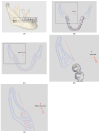The Three-Dimensional Investigation of the Radiographic Boundary of Mandibular Full-Arch Distalization in Different Facial Patterns
- PMID: 39590563
- PMCID: PMC11595643
- DOI: 10.3390/jpm14111071
The Three-Dimensional Investigation of the Radiographic Boundary of Mandibular Full-Arch Distalization in Different Facial Patterns
Abstract
Objective: Mandibular full-arch distalization (MFD) is a popular approach, particularly in non-extraction cases. However, we still cannot confirm whether facial patterns affect the amount of limits. This study aimed to determine the anatomical MFD limits in patients with different facial patterns.
Study design: Using computed tomography (CT), the shortest distances from the mandibular second molar to the inner cortex of the mandibular lingual surface and from the lower central incisor to the inner cortex of the lingual mandibular symphysis were measured in 60 samples (30 patients). The available distalization space in both regions was compared between groups with different facial patterns.
Results: The available space in symphysis was more critical than that in retromolar area: the shortest distances to the inner cortex of the lingual mandibular symphysis at root levels 8 mm apical to the cementoenamel junction of the incisor were 1.28, 1.60, and 3.48 mm in the high-, normal-, and low-angle groups, respectively.
Conclusions: Facial patterns affected the MFD capacity, and the thickness of the lingual mandibular symphysis was the most critical anatomic limit encountered. Practitioners should always pay attention to the possible impacts from facial patterns, especially in the treatment of high-angle cases.
Keywords: computed tomography; facial pattern; full-arch distalization; mandible.
Conflict of interest statement
The authors declare no conflicts of interest.
Figures





References
-
- Ye J.-A., Tsai C.-Y., Lee Y.-H., Chang Y.-J., Lin S.-S., Lai J.-P., Wu T.-J. Could cephalometric landmarks serve as boundaries of maxillary molar distalization? A comparison between two-and three-dimensional assessments. Taiwan. J. Orthod. 2021;33:1. doi: 10.38209/2708-2636.1105. - DOI
-
- Park J.H., Kook Y.-A., Kim Y.J., Lee N.-K. Biomechanical considerations for total distalization of the maxillary dentition using TSADs. Semin. Orthod. 2020;26:139–147. doi: 10.1053/j.sodo.2020.06.011. - DOI
Grants and funding
LinkOut - more resources
Full Text Sources

